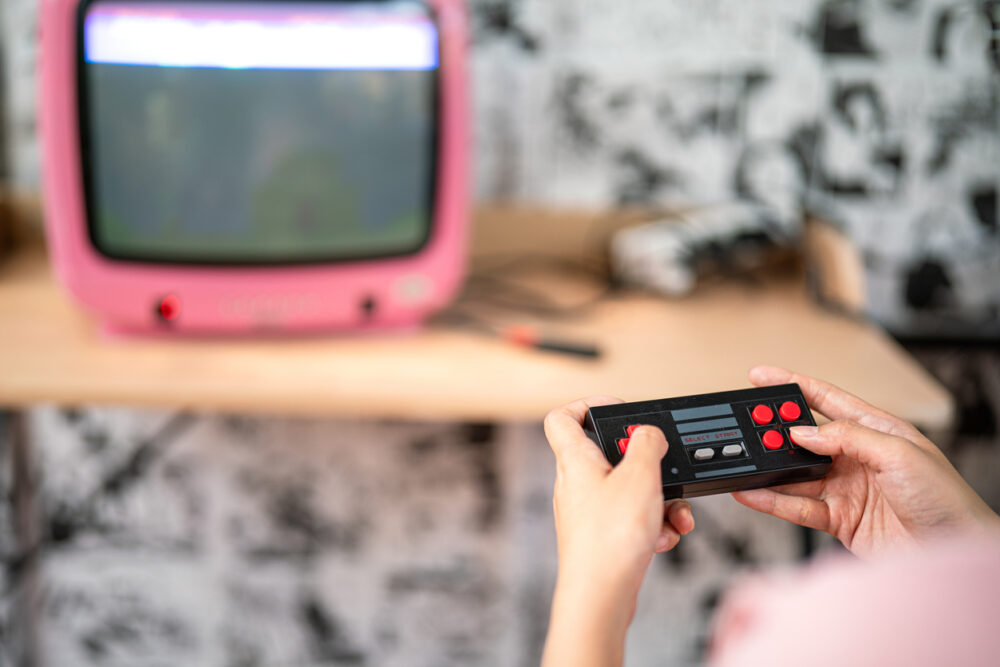Old gadgets now carry more weight than new upgrades.

In 2025, retro isn’t just aesthetic—it’s emotional currency. Devices that once felt obsolete are now status objects, storytelling props, and creative tools for younger generations. Nostalgia isn’t about rejecting progress; it’s about finding comfort and identity in the familiar hum of older tech.
Digital nostalgia thrives because it connects memory with modern context. These relics return not as novelties but as anchors, proving that in a hyper-accelerated world, sometimes slow tech feels more powerful.
1. Flip phones signal intentional disconnection.

Clamshell phones, once mocked, now reappear as statements of control. Closing a call with a snap feels more deliberate than tapping a glass rectangle. For younger users, they’re shields against constant pings.
The appeal isn’t just minimalism—it’s ritual. A flip phone lets you step outside without carrying the internet in your palm. Retro becomes rebellion, and suddenly, what once embarrassed teens becomes a badge of balance in an over-connected age.
2. Disposable cameras revive anticipation.

Film photography demands patience. You don’t see results instantly, which makes the reveal thrilling. Disposable cameras, especially at concerts and trips, transform quick snaps into souvenirs with texture.
Digital filters mimic grain, but real film feels tactile. The comeback is fueled by scarcity—each frame matters, every click costs something. Waiting weeks for prints turns images into events rather than disposable files. The pause is what makes them powerful.
3. MP3 players return as focus machines.

Streaming apps tempt with endless skips, notifications, and distractions. MP3 players cut that noise. A pocket-sized device loaded with chosen songs becomes a focus tool, a way to soundtrack life without algorithms pushing playlists.
For students and workers, it’s a quiet hack. Playlists live offline, ads disappear, and your attention doesn’t fracture. What was once cutting-edge is now a productivity shield, proving that limits sometimes create the best freedom.
4. Wired headphones carry cultural weight again.

AirPods once dominated, but wired headphones have slipped back into cool territory. They’re cheaper, harder to lose, and iconic in street-style culture. Their cord, once mocked, now signals retro authenticity.
They also avoid battery anxiety. Plug in, press play, and the music flows. For a generation chasing vintage aesthetics on TikTok, wired headphones double as accessories, bridging function with fashion in ways wireless buds can’t match.
5. Game consoles go retro with intent.

Classic consoles like the Nintendo 64 and PlayStation 2 aren’t gathering dust—they’re resurfacing at parties and streaming setups. Their pixelated charm contrasts sharply with the hyper-polished graphics of today.
Playing them isn’t just nostalgia—it’s community. Friends crowd around one screen, controllers in hand, reliving a format modern gaming often forgets. In an age of solo scrolls, shared play feels radical again. Retro consoles thrive because they remind us that joy is sometimes eight bits wide.
6. Instant messaging apps resurface as safe havens.

Once dismissed as relics, platforms like AIM and MSN Messenger are creeping back in revival forms. Their stripped-down design and absence of social feeds create digital spaces that feel oddly safe compared to today’s noise-heavy apps.
For Gen Z, these platforms represent intimacy—status updates, away messages, and one-on-one chats that don’t broadcast everything. They’re slower, calmer, and nostalgic enough to feel new again. Sometimes less connection actually builds stronger connections.
7. Polaroid cameras reinvent memory-making.

Instant cameras never fully disappeared, but their resurgence is stronger than ever. Gen Z embraces Polaroids as both art and resistance against digital oversaturation. A snapshot printed in seconds becomes an artifact rather than a swipe.
The white borders and physicality make them social currency at gatherings. Unlike cloud backups, they can’t be filtered endlessly. They capture imperfection, which is exactly what makes them feel authentic. In a world of polished feeds, flaws have become the luxury.
8. CD collections become mood-driven rituals.

Dusty jewel cases once stacked under car seats now re-emerge as prized collections. For some, the ritual of picking an album, sliding it into a player, and committing to the whole tracklist feels refreshing in an era of shuffle culture.
Collectors also value the artwork, liner notes, and tactile choices streaming stripped away. A CD stack isn’t clutter—it’s personality in plastic squares. Rebuilding collections isn’t just hobbyist pride; it’s reclaiming a slower rhythm of listening where albums mattered as wholes, not just playlists.
9. Typewriters find a second act in creativity.

Writers rediscover typewriters for the sound, the permanence, and the forced focus. No notifications, no tabs—just keys striking ink on paper. The limitations become superpowers for those drowning in digital distraction.
Typewriters aren’t about efficiency; they’re about texture. Pages carry weight, smudges, and finality. For creators, that tangibility restores meaning to words often lost in infinite drafts. Owning one today isn’t retro posturing—it’s choosing to slow down enough to listen to your own thoughts.
